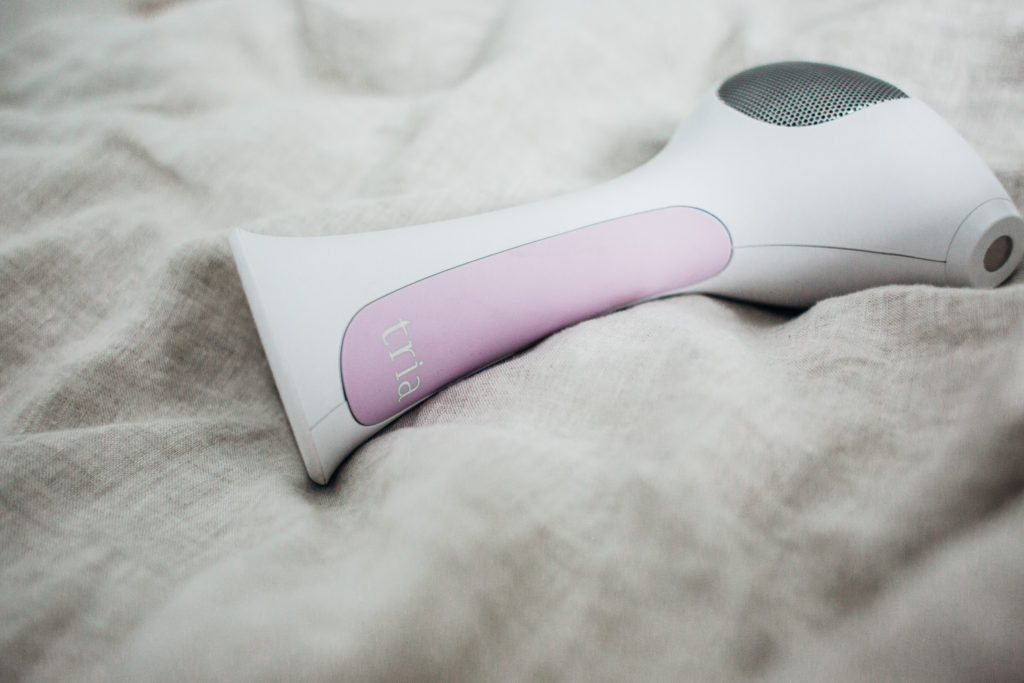TRIA HOME LASER HAIR REMOVAL

TRIA Beauty, Inc is a company that makes laser devices for home use. Their two main products are the Tria Hair Removal Laser and the Tria Clarifying Blue Light laser for home use to resolve acne. These are both available without a prescription. (1)
How the Tria Hair Removal Laser Works
The Tria Hair Removal Laser utilizes the technology of selective photothermolysis. This laser emits light at a wavelength that is absorbed by the black and brown melanin pigment in hair. (2) This is done by matching the absorption of the melanin (also known as the “chromophore”) with a laser of a corresponding wavelength to selectively target the hair. (3) Thus, ideally the wavelength of laser light should be selectively absorbed by melanin only within the hair bulb, destroying only the hair and theoretically resulting in permanent removal. (3) However, total removal of hair is uncommon, and realistic expectations for treatment include less hair, lighter hair, and thinner hair. In general, dark hair responds best because it has more melanin to be targeted by the laser. (3)
Additionally, structures within adjacent skin can cause laser energy to be absorbed by pigment in the epidermis in addition to melanin within the hair bulb. This reduces the efficacy of the treatment and can cause severe side effects. This is why the ideal subjects for laser hair removal are light skinned people with dark hair. (3)
Hair goes through growth phases, and is most sensitive to laser treatment while it is in the anagen (or active growth) phase. To ensure all hairs have been treated during this most sensitive phase of growth, multiple treatments are needed. (3)
Tria Hair Removal Laser – Claims
The Tria is a hand-held laser that operates at 810 nm and has 3 settings: low (with an energy of 7 J/cm2, PW 125 ms), medium (12 J/cm2 PW 225 ms), and high (20 J/cm2 PW 400 ms). (5) Bi-weekly treatments are recommended for at least 6 months based on the average time it takes for the majority of hair follicles to move through an entire growth cycle. However, during a treatment cycle some hair follicles will be dormant and cannot be seen. (2) Therefore, if the hair is not present it will not benefit from the laser treatment. Additionally, once the hair follicle is treated and disabled, it continues to work to eject the hair that was under the surface of the skin. This process takes up to 2 weeks to complete. (2) The hair will still be present, but is no longer growing.
The benefit of using laser hair removal is the results will be permanent. However, after 1 treatment there will be no visible change (and shaving between treatments, not waxing or plucking because you need the base of the hair to be intact). After 2-3 months hair growth will appear lighter and finer, and eventually 6 months later hair follicles disabled by the TRIA Laser will no longer grow hair. (2)
Side Effects
The treatment sensation varies depending on the person and treatment area. Sometime it is a warm, prickling sensation, sometimes pain. For best results, it is recommended to increase the level until you’ve reached the highest setting that you can tolerate. (2) Additionally, common side effects of hair removal are pain and possible folliculitis (inflammation of the hair follicle). (3)
Studies
In one 2007 study, subjects used the 810 nm diode laser Tria at home to treat unwanted hair. Subjects were given written and video instructions, and treatment energies were patient-selected based on low, medium, and high settings (with the highest tolerable setting preferred for the best clinical results). Typical treatment time for an average axilla (armpit) was 10 to 20 minutes likely due to a smaller spot size (1cm) of the laser. The Tria was effective at reducing hair regrowth (with an average of 41% reduction at 6-month follow-up) and with minimal side effects after three treatments delivered at 3-week time intervals. (4)
This is the only large peer-reviewed publication to date of the Tria and was sponsored by SpectraGenics, Inc. It has been cleared by the Food and Drug Administration (FDA) for at-home use to treat unwanted hair on the bikini area, legs, underarms, arms, back, and stomach. However, it is not FDA approved for use on the face, head, or neck. (5)
References:
- What is Tria? TRIA Beauty, Inc. Accessed May 26, 2011.http://www.triabeauty.com/info/what-is-tria.htm
- Hair Removal, How it Works. TRIA Beauty, Inc. Accessed May 26, 2011. http://www.triabeauty.com/info/hair-removal-how-it-works.htm
- Donald W Shenenberger. Removal of unwanted hair.October 3, 2010. http://www.uptodate.com/contents/removal-of-unwanted-hair?source=search_result&selectedTitle=1%7E12#H11
- Wheeland RG. Simulated consumer use of a battery-powered, hand-held, portable diode laser (810 nm) for hair removal: a safety, efficacy and ease-of-use study. Lasers Surg Med 2007;39:476–93.


